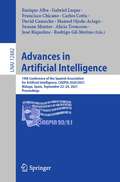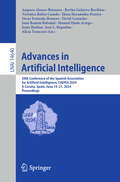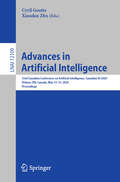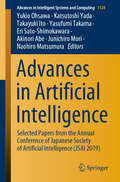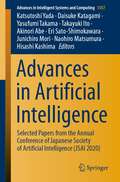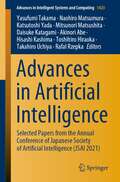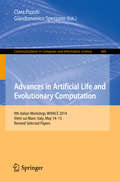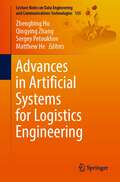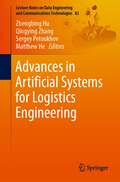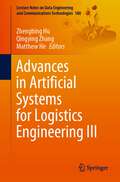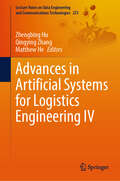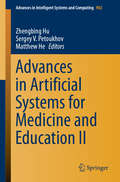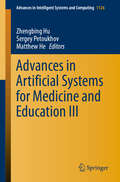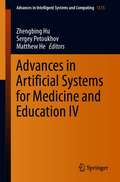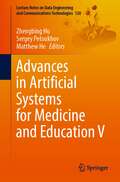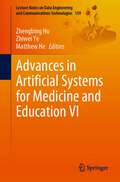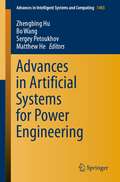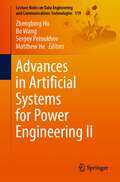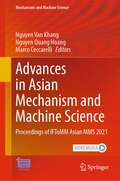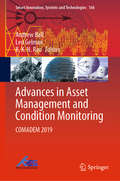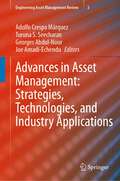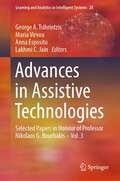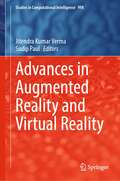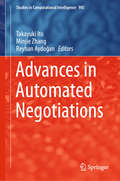- Table View
- List View
Advances in Artificial Intelligence: 19th Conference of the Spanish Association for Artificial Intelligence, CAEPIA 2020/2021, Málaga, Spain, September 22–24, 2021, Proceedings (Lecture Notes in Computer Science #12882)
by Enrique Alba Francisco Chicano Gabriel Luque Alicia Troncoso Manuel Ojeda-Aciego David Camacho Carlos Cotta Susana Montes José Riquelme Rodrigo Gil-MerinoThis book constitutes the refereed proceedings of the 19th Conference of the Spanish Association for Artificial Intelligence, CAEPIA 2020, which was cancelled due to the COVID-19 pandemic, amalgamated with CAEPIA 2021, and held in Malaga, Spain, during September 2021.The 25 full papers presented were carefully selected from 40 submissions. The Conference of the Spanish Association of Artificial Intelligence (CAEPIA) is a biennial forum open to researchers from all over the world to present and discuss their latest scientific and technological advances in Antificial Intelligence (AI). The book is subdivided into the following topical headings: machine learning, optimization and search, and real-world applications. It covers such themes as ambient intelligence and smart environments; computer vision and robotics; constraints, search and planning; creativity and A.I.; education and A.I.; explainable and responsible A.I.; foundation, models and applications of A.I, and others.
Advances in Artificial Intelligence: 20th Conference of the Spanish Association for Artificial Intelligence, CAEPIA 2024, A Coruña, Spain, June 19–21, 2024, Proceedings (Lecture Notes in Computer Science #14640)
by Alicia Troncoso Manuel Ojeda-Aciego David Camacho Amparo Alonso-Betanzos Oscar Fontenla-Romero Jesús Medina Verónica Bolón-Canedo José C. Riquelme Bertha Guijarro-Berdiñas Elena Hernández-Pereira Juan Ramón RabuñalThis book constitutes the refereed proceedings of the 20th Conference of the Spanish Association for Artificial Intelligence, CAEPIA 2024, held in A Coruña, Spain, during June 19–21, 2024. The 27 full papers presented in this book were carefully reviewed and selected from 38 submissions. CAEPIA is a forum open to researchers from all over the world to present and discuss their latest scientific and technological advances in Artificial Intelligence (AI). The papers cover such themes as: machine learning, search and optimization, creativity and AI, ontologies and knowledge graphs, education and AI, foundation, models and applications of AI, uncertainty in AI, ambient intelligence and smart environments, explainable and responsible AI, fuzzy logic, natural language processing, knowledge representation, reasoning and logic, constraints, search and planning, multi-agent systems, computer vision and robotics, and intelligent web and information retrieval.
Advances in Artificial Intelligence: 33rd Canadian Conference on Artificial Intelligence, Canadian AI 2020, Ottawa, ON, Canada, May 13–15, 2020, Proceedings (Lecture Notes in Computer Science #12109)
by Xiaodan Zhu Cyril GoutteThis book constitutes the refereed proceedings of the 33rd Canadian Conference on Artificial Intelligence, Canadian AI 2020, which was planned to take place in Ottawa, ON, Canada. Due to the COVID-19 pandemic, however, it was held virtually during May 13–15, 2020.The 31 regular papers and 24 short papers presented together with 4 Graduate Student Symposium papers were carefully reviewed and selected from a total of 175 submissions. The selected papers cover a wide range of topics, including machine learning, pattern recognition, natural language processing, knowledge representation, cognitive aspects of AI, ethics of AI, and other important aspects of AI research.
Advances in Artificial Intelligence: Selected Papers from the Annual Conference of Japanese Society of Artificial Intelligence (JSAI 2019) (Advances in Intelligent Systems and Computing #1128)
by Takayuki Ito Katsutoshi Yada Yukio Ohsawa Yasufumi Takama Eri Sato-Shimokawara Akinori Abe Junichiro Mori Naohiro MatsumuraThis book presents selected and extended papers from the largest conference on artificial intelligence in Japan, which was expanded into an internationalized event for the first time in 2019: the 33rd Annual Conference of the Japanese Society for Artificial Intelligence (JSAI 2019), held on June 4–June 7, 2019 at TOKI MESSE in Niigata, Japan. The book’s content has been divided into six major sections, on (I) knowledge engineering, (II) agents, (III) education and culture, (IV) natural language processing, (V) machine learning and data mining, and (VI) cyber physics. Given its scope, the book offers a valuable reference guide for professionals, undergraduate and graduate students engaged in disciplines, fields, technologies, or philosophies relevant to AI, e.g., computer/data science, robotics, linguistics, and physics, introducing them to recent advances in this area and discussing the human society of tomorrow.
Advances in Artificial Intelligence: Selected Papers from the Annual Conference of Japanese Society of Artificial Intelligence (JSAI 2020) (Advances in Intelligent Systems and Computing #1357)
by Takayuki Ito Katsutoshi Yada Yasufumi Takama Eri Sato-Shimokawara Akinori Abe Junichiro Mori Naohiro Matsumura Daisuke Katagami Hisashi KashimaThis book contains expanded versions of research papers presented at the international sessions of Annual Conference of the Japanese Society for Artificial Intelligence (JSAI), which was held online in June 2020. The JSAI annual conferences are considered key events for our organization, and the international sessions held at these conferences play a key role for the society in its efforts to share Japan’s research on artificial intelligence with other countries. In recent years, AI research has proved of great interest to business people. The event draws both more and more presenters and attendees every year, including people of diverse backgrounds such as law and the social sciences, in additional to artificial intelligence. We are extremely pleased to publish this collection of papers as the research results of our international sessions.
Advances in Artificial Intelligence: Selected Papers from the Annual Conference of Japanese Society of Artificial Intelligence (JSAI 2021) (Advances in Intelligent Systems and Computing #1423)
by Katsutoshi Yada Rafal Rzepka Yasufumi Takama Akinori Abe Naohiro Matsumura Takahiro Uchiya Daisuke Katagami Hisashi Kashima Mitsunori Matsushita Toshihiro HiraokaThis book contains extended versions of research papers presented at the international sessions at the 35th Annual Conference of the Japanese Society for Artificial Intelligence (JSAI2021), which was held online from June 8–11, 2021. The JSAI annual conferences are considered key events for our organization, and the international sessions held at these conferences play a key role for the society in its efforts to share Japan’s research on artificial intelligence with other countries. The topics of the international sessions in JSAI2021 cover five categories: knowledge engineering, machine learning, agents, robots and real worlds, and human interface and education aid. From the papers submitted to those categories, papers of high quality were selected through the strict reviewing procedure. As a result, 19 papers are included in this book. From this book, readers can get an overview of recent Japan’s research on artificial intelligence.
Advances in Artificial Life and Evolutionary Computation: 9th Italian Workshop, WIVACE 2014, Vietri sul Mare, Italy, May 14-15, Revised Selected Papers (Communications in Computer and Information Science #445)
by Clara Pizzuti Giandomenico SpezzanoThis book constitutes the revised selected papers of the 9th Italian Workshop on Advances in Artificial Life and Evolutionary Computation held in Vietri sul Mare, Italy, in May 2014, in conjunction with the 24th Italian Workshop on Neural Networks, WIRN 2014. The 16 papers presented have been thoroughly reviewed and selected from 40 submissions. They cover the following topics: artificial neural networks; fuzzy inference systems; rough set; approximate reasoning; and optimization methods such as evolutionary computation, swarm intelligence, particle swarm optimization.
Advances in Artificial Systems for Logistics Engineering (Lecture Notes on Data Engineering and Communications Technologies #135)
by Sergey Petoukhov Matthew He Zhengbing Hu Qingying ZhangThe book comprises high-quality refereed research papers presented at the Second International Conference on Artificial Intelligence and Logistics Engineering (ICAILE2022), held in Kyiv, Ukraine, on February 20–22, 2022, organized jointly by the National Technical University of Ukraine "Igor Sikorsky Kyiv Polytechnic Institute," Wuhan University of Technology, Nanning University, National Aviation University, and the International Research Association of Modern Education and Computer Science. The topics discussed in the book include state-of-the-art papers in artificial intelligence and logistics engineering. It is an excellent source of references for researchers, graduate students, engineers, management practitioners, and undergraduate students interested in artificial intelligence and its applications in logistics engineering.
Advances in Artificial Systems for Logistics Engineering (Lecture Notes on Data Engineering and Communications Technologies #82)
by Sergey Petoukhov Matthew He Zhengbing Hu Qingying ZhangThis book comprises high-quality refereed research papers presented at the 2021 International Conference on Artificial Intelligence and Logistics Engineering (ICAILE2021), held in Kyiv, Ukraine, on 22–24 January 2021, organized jointly by Wuhan University of Technology, National Technical University of Ukraine “Igor Sikorsky Kyiv Polytechnic Institute” and the International Research Association of Modern Education and Computer Science. The topics discussed in the book include state-of-the-art papers in artificial intelligence and logistics engineering. It is an excellent source of references for researchers, graduate students, engineers, management practitioners and undergraduate students interested in artificial intelligence and their applications in logistics engineering.
Advances in Artificial Systems for Logistics Engineering III (Lecture Notes on Data Engineering and Communications Technologies #180)
by Matthew He Zhengbing Hu Qingying ZhangThis book comprises high-quality refereed research papers presented at the 3rd International Conference on Artificial Intelligence and Logistics Engineering (ICAILE2023), held in Wuhan, China, on March 11–12, 2023, organized jointly by Wuhan University of Technology, Nanning University, the National Technical University of Ukraine "Igor Sikorsky Kyiv Polytechnic Institute", Huazhong University of Science and Technology, the Polish Operational and Systems Society, Wuhan Technology and Business University, and the International Research Association of Modern Education and Computer Science. The topics discussed in the book include state-of-the-art papers in artificial intelligence and logistics engineering. It is an excellent source of references for researchers, graduate students, engineers, management practitioners, and undergraduate students interested in artificial intelligence and its applications in logistics engineering.
Advances in Artificial Systems for Logistics Engineering IV (Lecture Notes on Data Engineering and Communications Technologies #223)
by Matthew He Zhengbing Hu Qingying ZhangThe book comprises high-quality refereed research papers presented at the 4th International Conference on Artificial Intelligence and Logistics Engineering (ICAILE2024), held in Guiyang, China, on April 16–17, 2024, was organized jointly by Wuhan University of Technology, the National Technical University of Ukraine "Igor Sikorsky Kyiv Polytechnic Institute", the Polish Operational and Systems Society, Wuhan Technology and Business University, Guizhou Vocational and Technical College of Transportation, and the International Research Association of Modern Education and Computer Science. The topics discussed in the book include state-of-the-art papers in artificial intelligence and logistics engineering. It is an excellent source of references for researchers, graduate students, engineers, management practitioners, and undergraduate students interested in artificial intelligence and its applications in logistics engineering.
Advances in Artificial Systems for Medicine and Education II (Advances in Intelligent Systems and Computing #902)
by Matthew He Zhengbing Hu Sergey V. PetoukhovThis book includes the proceedings of the Second International Conference of Artificial Intelligence, Medical Engineering, Education (AIMEE2018), held in Moscow, Russia, on 6–8 October 2018. The conference covered advances in the development of artificial intelligence systems and their applications in various fields, from medicine and technology to education. The papers presented in the book discuss topics in mathematics and biomathematics; medical approaches; and technological and educational approaches. Given the rapid development of artificial intelligence systems, the book highlights the need for more intensive training for a growing number of specialists, particularly in medical engineering, to increase the effectiveness of medical diagnosis and treatment. The book is intended for specialists, students and other readers who would like to know where artificial intelligence systems can beneficially be applied in the future.
Advances in Artificial Systems for Medicine and Education III (Advances in Intelligent Systems and Computing #1126)
by Sergey Petoukhov Matthew He Zhengbing HuThis book discusses the latest advances in the development of artificial intelligence systems and their applications in various fields, from medicine and technology to education. It comprises papers presented at the Third International Conference of Artificial Intelligence, Medical Engineering, Education (AIMEE2019), held at the Mechanical Engineering Institute of the Russian Academy of Sciences, Moscow, Russia, on 1–3 October 2019. Covering topics such as mathematics and biomathematics; medical approaches; and technological and educational approaches, it is intended for the growing number of specialists and students in this field, as well as other readers interested in discovering where artificial intelligence systems can be applied in the future.
Advances in Artificial Systems for Medicine and Education IV (Advances in Intelligent Systems and Computing #1315)
by Sergey Petoukhov Matthew He Zhengbing HuThis book covers the latest advances for the development of artificial intelligence systems and their applications in various fields from medicine and technology to education. The proceedings comprise refereed papers presented at the Fourth International Conference of Artificial Intelligence, Medical Engineering, Education (AIMEE2020), held at the Mechanical Engineering Institute of the Russian Academy of Sciences, Moscow, Russia, in 3–4 October 2020. Given the rapid development of artificial intelligence systems, the book emphasizes the need for the intensification of training of a growing number of relevant specialists, in particular, in medical engineering to increase the effectiveness of medical diagnosing and treatment. In digital artificial intelligence systems, scientists endeavor to reproduce the innate intellectual abilities of human and other organisms, and the in-depth study of genetic systems and inherited biological processes can provide new approaches to create more and more effective artificial intelligence methods. Topics of the included papers concern thematic materials in the following spheres: mathematics and biomathematics; medical approaches; technological and educational approaches. The book is a compilation of state-of-the-art papers in the field, covering a comprehensive range of subjects that is relevant to business managers and engineering professionals alike. The breadth and depth of these proceedings make them an excellent resource for asset management practitioners, researchers, and academics, as well as undergraduate and postgraduate students interested in artificial intelligence and bioinformatics systems as well as their growing applications. Intended readership includes specialists, students, and other circles of readers who would like to know where artificial intelligence systems can be applied in the future with great benefit.
Advances in Artificial Systems for Medicine and Education V (Lecture Notes on Data Engineering and Communications Technologies #107)
by Sergey Petoukhov Matthew He Zhengbing HuThis book broadly covers a scope of the latest advances for the development of artificial intelligence systems and their applications in various fields from medicine and technology to education. The proceedings comprise refereed papers presented at the Fifth International Conference of Artificial Intelligence, Medical Engineering, and Education (AIMEE2021), which took place at the Mechanical Engineering Institute of the Russian Academy of Sciences, Moscow, Russia, on 1–3 October 2021. Given the rapid development of artificial intelligence systems, the book emphasizes the need for the intensification of training of a growing number of relevant specialists, in particular, in medical engineering to increase the effectiveness of medical diagnosing and treatment. In digital artificial intelligence systems, scientists endeavour to reproduce the innate intellectual abilities of humans and other organisms, and the in-depth study of genetic systems and inherited biological processes can provide new approaches to create more and more effective artificial intelligence methods. Topics of the included papers concern thematic materials in the following spheres: mathematics and biomathematics; medical approaches; technological and educational approaches. The book is a compilation of cutting-edge research papers in the field, covering a comprehensive range of subjects that are relevant to business managers and engineering professionals alike. The breadth and depth of these proceedings make them an excellent resource for asset management practitioners, researchers, and academics, as well as undergraduate and postgraduate students who are interested in artificial intelligence, bioinformatics systems, also their expanding applications. The intended readership includes specialists, students, and other circles of readers who would like to know where artificial intelligence systems can be applied in the future with great benefit.
Advances in Artificial Systems for Medicine and Education VI (Lecture Notes on Data Engineering and Communications Technologies #159)
by Matthew He Zhengbing Hu Zhiwei YeThe book provides a thorough overview of recent developments in the design of AI systems and their uses in a range of industries, including education, technology, and bioinformatics. The papers in the proceedings were presented at the Sixth International Conference on Artificial Intelligence, Medical Engineering, and Education (AIMEE2022), which took place in Wuhan, China, from August 19 to 21, 2022. The book underlines the need for the intensification of training of an increasing number of appropriate specialists given the rapid growth of AI systems. In order to replicate human and other species' natural intelligence in digital AI systems, the researchers have been studying genetics and inherited biological processes in-depth. These studies offer fresh ideas for developing ever more powerful AI techniques. The featured articles cover a variety of themes in the fields of mathematics and biomathematics, medical approaches, technical and educational approaches, and medical approaches. The book is a compilation of recent academic papers in the discipline, covering a wide range of topics that are important to both business managers and engineers. This proceedings is a fantastic resource for asset management practitioners, researchers, and academics, as well as undergraduate and graduate students who are interested in AI, bioinformatics systems, and their developing applications. This is due to the breadth and depth of the proceedings. Experts, students, and other people who are interested in learning about how AI systems might be used in the future are the target audience.
Advances in Artificial Systems for Power Engineering (Advances in Intelligent Systems and Computing #1403)
by Sergey Petoukhov Matthew He Bo Wang Zhengbing HuThis book comprises refereed papers presented at The International Conference on Artificial Intelligence and Power Engineering (AIPE2020), held in Moscow, Russia, on December 25–27, 2020. The book's/conference's general scope covers the latest advances for the development of artificial intelligence systems and their applications in various fields from power engineering to biology and education. Given the rapid development of artificial intelligence systems, the book emphasizes the need for the intensification of training of a growing number of relevant specialists, in particular, in energy and power engineering to increase the effectiveness of creation and diagnosing of appropriate technical solutions. In digital artificial intelligence systems, scientists endeavor to reproduce the innate intellectual abilities of humans and other organisms. The in-depth study of biological and self-organizing systems provides new approaches to create more and more effective artificial intelligence methods. Topics of the included papers concern thematic materials in the following spheres: mathematics and computer algorithms; analysis of some technical solutions; technological and educational approaches. The book is a compilation of state-of-the-art papers in the field, covering a comprehensive range of subjects that are relevant to business managers and engineering professionals alike. The breadth and depth of these proceedings make them an excellent resource for asset management practitioners, researchers, and academics, as well as undergraduate and postgraduate students interested in artificial intelligence systems and their growing applications. The intended readership includes specialists, students, and other circles of readers who would like to know where artificial intelligence systems can be applied in the future with great benefit.
Advances in Artificial Systems for Power Engineering II (Lecture Notes on Data Engineering and Communications Technologies #119)
by Sergey Petoukhov Matthew He Bo Wang Zhengbing HuThis book includes refereed papers presented at the Second International Conference on Artificial Intelligence and Power Engineering (AIPE2021), which was held in Moscow, Russia, on December 17–19, 2021. The general scope of the book includes the most recent advances in the development of artificial intelligence systems and their applications in a variety of fields, ranging from power engineering to biology and education. Given the rapid development of artificial intelligence systems, the book emphasizes the importance of intensifying training for a growing number of relevant specialists, particularly in energy and power engineering, in order to improve the effectiveness of the creation and diagnosis of appropriate technical solutions. Scientists are attempting to replicate the innate intellectual abilities of humans and other organisms in digital artificial intelligence systems. In-depth research into biological and self-organizing systems can provide new approaches for developing more and more effective artificial intelligence methods. The papers included in this volume cover thematic materials in the following areas: mathematics and computer algorithms; analysis of some technical solutions; and technological and educational approaches. The book is a collection of cutting-edge papers in the field, covering a wide range of topics relevant to both business managers and engineering professionals. These proceedings are an excellent resource for asset management practitioners, researchers, and academics, as well as undergraduate and postgraduate students interested in artificial intelligence systems and their expanding applications, due to their breadth and depth. The intended readership includes specialists, students, and other groups of readers who want to know where artificial intelligence systems can be used to great advantage in the future.
Advances in Asian Mechanism and Machine Science: Proceedings of IFToMM Asian MMS 2021 (Mechanisms and Machine Science #113)
by Marco Ceccarelli Nguyen Van Khang Nguyen Quang HoangThis book presents the proceedings of the 6th IFToMM Asian Mechanisms and Machine Science Conference (Asian MMS), held in Hanoi, Vietnam on December 15-18, 2021. It includes peer-reviewed papers on the latest advances in mechanism and machine science, discussing topics such as biomechanical engineering, computational kinematics, the history of mechanism and machine science, gearing and transmissions, multi-body dynamics, robotics and mechatronics, the dynamics of machinery, tribology, vibrations, rotor dynamics and vehicle dynamics. A valuable, up-to-date resource, it offers an essential overview of the subject for scientists and practitioners alike, and will inspire further investigations and research.
Advances in Asian Mechanism and Machine Science: Proceedings of IFToMM Asian MMS 2024 (Mechanisms and Machine Science #167)
by Marco Ceccarelli Amandyk Tuleshov Assylbek JomartovThis book presents the proceedings of the 7th IFToMM Asian Mechanisms and Machine Science Conference (Asian MMS), held in Almaty, Kazakhstan, on August 28–30, 2024. It includes peer-reviewed papers on the latest advances in mechanism and machine science, discussing topics such as biomechanical engineering, computational kinematics, the history of mechanism and machine science, gearing and transmissions, multi-body dynamics, robotics and mechatronics, the dynamics of machinery, tribology, vibrations, rotor dynamics, and vehicle dynamics. A valuable, up-to-date resource, it offers an essential overview of the subject for scientists and practitioners alike and will inspire further investigations and research.
Advances in Asset Management and Condition Monitoring: COMADEM 2019 (Smart Innovation, Systems and Technologies #166)
by Len Gelman Andrew Ball B. K. N. RaoThis book gathers select contributions from the 32nd International Congress and Exhibition on Condition Monitoring and Diagnostic Engineering Management (COMADEM 2019), held at the University of Huddersfield, UK in September 2019, and jointly organized by the University of Huddersfield and COMADEM International. The aim of the Congress was to promote awareness of the rapidly emerging interdisciplinary areas of condition monitoring and diagnostic engineering management. The contents discuss the latest tools and techniques in the multidisciplinary field of performance monitoring, root cause failure modes analysis, failure diagnosis, prognosis, and proactive management of industrial systems. There is a special focus on digitally enabled asset management and covers several topics such as condition monitoring, maintenance, structural health monitoring, non-destructive testing and other allied areas. Bringing together expert contributions from academia and industry, this book will be a valuable resource for those interested in latest condition monitoring and asset management techniques.
Advances in Asset Management: Strategies, Technologies, and Industry Applications (Engineering Asset Management Review #3)
by Adolfo Crespo Márquez Joe Amadi-Echendu Georges Abdul-Nour Turuna S. SeecharanThis book discusses asset life-cycle management, especially, human dimensions on the management of infrastructure and industry-sector assets. The book explores advances decision support systems based on the applications of Fourth Industrial Revolution (4IR) technologies such as augmented reality (AR) and virtual reality (VR), machine learning, and digital twinning for monitoring, diagnostics, prognostics. It includes methodologies and cases applied to different operational contexts. The book also considers the implications of the applications of international standards, local regulations and industry guidelines to risk and resilience engineering asset operations.
Advances in Assistive Technologies: Selected Papers in Honour of Professor Nikolaos G. Bourbakis – Vol. 3 (Learning and Analytics in Intelligent Systems #28)
by Lakhmi C. Jain Maria Virvou George A. Tsihrintzis Anna EspositoThis book aims at exposing its readers to some of the most significant advances in assistive technologies. Assistive technologies develop devices to assist vulnerable people, including elderly people, people with cognitive disabilities such as memory problems or dementia, and people with functional disabilities such as those needing support in toileting, moving around, eating, bathing, dressing, grooming, and taking personal care. The ever-increasing life expectancy and world population, along with the emergence of new diseases and the regrettable continuation of armed conflicts, press for development and availability of assistive technologies that offer people in need the opportunity to live secure and controlled lives with more active participation in society and at a reduced assistive cost. This task can be accomplished only with more advanced devices than traditional-powered wheelchairs or eating/drinking devices, including prosthetics, exoskeletons, visual and hearing aids, cognitive aids, and devices enhanced with artificial intelligence.The book consists of an editorial note and an additional twelve (12) chapters, all of which have been written by authors who work on the corresponding chapter theme and are recognized for their significant research contributions. In more detail, the chapters in the book are organized into four parts, namely (i) Advances in Assistive Technologies in Healthcare, (ii) Advances in Assistive Technologies in Medical Diagnosis, (iii) Advances in Assistive Technologies in Mobility and Navigation, and (iv) Advances in Privacy and Explainability in Assistive Technologies.This research book is directed towards professors, researchers, scientists, engineers, and students in assistive technologies. It is also directed towards readers who come from other disciplines and is interested in becoming versed in some of the most recent assistive technologies. An extensive list of bibliographic references at the end of each chapter guides its readers to probe further into the application areas of interest to them.
Advances in Augmented Reality and Virtual Reality (Studies in Computational Intelligence #998)
by Sudip Paul Jitendra Kumar VermaThis book gathers the recent advances in Augmented Reality (AR) and Virtual Reality (VR). It includes topics on classification of computer assisted environments, field-of-views on visuospatial memory in complex virtual environment, free-roam VR for gaming, simulation of physical processes in an electric circuit, motion study of mated gears, ternary reversible gates with virtual reality, inclusiveness of AR and VR for agricultural disease detection, application of AR and VR in medical and pharmaceuticals, drones for medical assistance, machine learning based AR technologies for human face detection, recognition, and automated vehicles for medical assistance. The book is targeted towards advancing undergraduate, graduate, and post graduate students, researchers, academicians, policymakers, various government officials, NGOs, and industry research professionals who are currently working in the field of science and technology either directly or indirectly to benefit the common masses.
Advances in Automated Negotiations (Studies in Computational Intelligence #905)
by Minjie Zhang Takayuki Ito Reyhan AydoğanThis book discusses important recent advances in automated negotiations. It introduces a number of state-of-the-art autonomous agents for large-scale and complex negotiations, and demonstrates that automated negotiation is one of the most important areas in the field of autonomous agents and multi-agent systems. Further, it presents automated negotiation scenarios involving negotiation encounters that may have, for instance, a large number of agents or a large number of issues with interdependencies and/or real-time constraints. This book includes carefully selected and reviewed outcomes of the 11th International Workshop on Automated Negotiations (ACAN) held in Stockholm, Sweden, 2018, in conjunction with IJCAI-ECAI-2018. Written by leading academic and industrial researchers, it is a valuable resource for professionals and scholars working on complex automated negotiations. Furthermore, the in-depth descriptions of automated negotiating agent programs help readers who are involved in writing codes for automated agents.
